HPE Aruba Networking 500 Series – Advanced Wi-Fi 6 Connectivity for Mid-Sized Environments
The Aruba AP-505 Access Point brings cost-effective, cutting-edge Wi-Fi 6 coverage to indoor spaces like medium-sized offices, schools, and retail outlets. Delivering a maximum combined data rate of 1.49 Gbps, it ensures seamless and reliable performance in medium-density networks, empowering businesses with the latest wireless technology.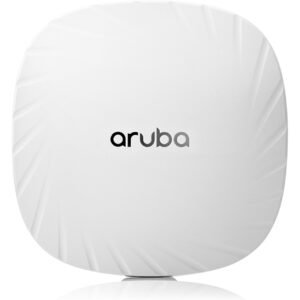
Key Wi-Fi 6 Technology Highlights:
- Increased Network Efficiency with OFDMA:Wi-Fi 6 introduces Orthogonal Frequency Division Multiple Access (OFDMA), which breaks down a single channel into smaller sub-channels. This allows multiple devices to transmit data simultaneously, reducing latency and improving performance in busy environments with high user activity.
- Enhanced Device Battery Life through Target Wake Time (TWT):TWT optimizes power consumption by scheduling device wake times. This feature significantly extends the battery life of connected devices, particularly IoT sensors, wearables, and smartphones, making it ideal for modern workplaces with numerous connected endpoints.
- Faster Speeds and Better Performance:By supporting wider channels (up to 160 MHz), 1024-QAM for higher data throughput, and reduced congestion on both 2.4 GHz and 5 GHz bands, Wi-Fi 6 ensures faster connections and more consistent performance, even in challenging network conditions.
Security and Reliability:
- Enhanced Security with WPA3 and Enhanced Open:WPA3 provides robust encryption for stronger password security, while Enhanced Open delivers secure guest access without requiring a password. Together, these features make networks safer and more trustworthy.
- Enhanced Security with Trusted Platform Module (TPM):All HPE Aruba Networking Access Points, including the AP-505, are equipped with a Trusted Platform Module (TPM) to safeguard critical credentials and keys. This ensures secure storage and integrity of boot code, providing enhanced device assurance and robust protection against potential threats.
- Seamless VPN Tunnels for Remote Deployments:In Remote Access Point (RAP) and IAP-VPN configurations, the 500 Series can establish secure SSL/IPSec VPN tunnels to a Mobility Controller acting as a VPN concentrator. This functionality allows secure and reliable remote connectivity for distributed teams or branch office setups.
Flexible Operation and Centralized Management
 The Aruba AP-505 offers versatile deployment options, operating as standalone access points or integrated with a gateway for improved scalability, security, and manageability. With Zero Touch Provisioning, these access points can be deployed without on-site technical expertise, making them ideal for branch offices and remote work setups.
The Aruba AP-505 offers versatile deployment options, operating as standalone access points or integrated with a gateway for improved scalability, security, and manageability. With Zero Touch Provisioning, these access points can be deployed without on-site technical expertise, making them ideal for branch offices and remote work setups.
For management, HPE Aruba Networking APs provide flexibility with both cloud-based and on-premises options, catering to campuses, branches, and remote environments. The Aruba Central platform offers a unified dashboard to monitor and manage wired and wireless LANs, WANs, and VPNs, ensuring streamlined operations across the network.
Why Choose the Aruba AP-505?
The Aruba AP-505 is Wi-Fi CERTIFIED™, ensuring compliance with the latest standards for reliability and performance. With its support for the 802.11ax standard, this access point is future-ready for evolving business needs. Additionally, it’s backed by a limited lifetime warranty for long-term peace of mind.
Common Wireless Network Architecture Diagrams for Small and Medium-sized Enterprises

Antenna Patterns
Horizontal Planes(top view)

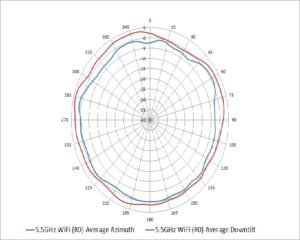
Vertical (elevation) planes (side view, AP facing down)


Aruba R2H28A Wi-Fi6 AP-505 Specification
| Model | AP-505 |
|---|---|
| AP type | Indoor, dual radio, 5 GHz and 2.4 GHz 802.11ax 2x2 MIMO |
| 5 GHz radio | Two spatial stream Single User (SU) MIMO for up to 1.2 Gbps wireless data rate with 2SS HE80 802.11ax client devices |
| 2.4 GHz radio | Two spatial stream Single User (SU) MIMO for up to 574 Mbps (287 Mbps) wireless data rate with 2SS HE40 (HE20) 802.11ax client devices |
| Maximum number of associated client devices | Up to 256 associated client devices per radio |
| Maximum number of BSSIDs | 16 BSSIDs per radio |
| Supported frequency bands (country‑specific restrictions apply) | 2.4 GHz and 5 GHz 2.400 to 2.4835 GHz 5.150 to 5.250 GHz 5.250 to 5.350 GHz 5.470 to 5.725 GHz 5.725 to 5.850 GHz 5.850 to 5.895 GHz ISM U-NIL-1 U-NII-2A U-NII-2C U-NII-3/ISM U-NII-4 |
| Available channels | Dependent on configured regulatory domain |
| Supported radio technologies | 802.11b: Direct-sequence spread-spectrum (DSSS) 802.11a/g/n/ac: Orthogonal frequency-division multiplexing (OFDM) 802.11ax: Orthogonal frequency-division multiple access (OFDMA) with up to 8 resource units |
| Supported modulation types: | 802.11b: BPSK, QPSK, CCK 802.11a/g/n: BPSK, QPSK, 16-QAM, 64-QAM, 256-QAM (proprietary extension) 802.11ac: BPSK, QPSK, 16-QAM, 64-QAM, 256-QAM, 1024-QAM (proprietary extension) 802.11ax: BPSK, QPSK, 16-QAM, 64-QAM, 256-QAM, 1024-QAM |
| 802.11n high-throughput (HT) support: | HT20/40 |
| 802.11ac very high throughput (VHT) support: | VHT20/40/80 |
| 802.11ax high efficiency (HE) support: | HE20/40/80 |
| Supported data rates (Mbps): | 802.11b: 1, 2, 5.5, 11 802.11a/g: 6, 9, 12, 18, 24, 36,48, 54 802.11n: 6.5 to 300 (MCS0 to MCS15, HT20 to HT40), 400 with 256-QAM 802.11ac: 6.5 to 867 (MCS0 to MCS9, NSS = 1 to 2, VHT20 to VHT80), 1,083 with 1024-QAM 802.11ax (2.4 GHz): 3.6 to 574 (MCS0 to MCS11, NSS = 1 to 2, HE20 to HE40) 802.11ax (5 GHz): 3.6 to 1,201 (MCS0 to MCS11, NSS = 1 to 2, HE20 to HE80) |
| 802.11n/ac/ax packet aggregation: | A-MPDU, A-MSDU |
| Transmit power: | Configurable in increments of 0.5 dBm |
| Maximum (aggregate, conducted total) transmit power (limited by local regulatory requirements): | 2.4 GHz band: +21 dBm (18 dBm per chain) 5 GHz band: +21 dBm (18 dBm per chain) Note: conducted transmit power levels exclude antenna gain. For total (EIRP) transmit power, add antenna gain. |
| Wi-Fi Antennas | Two integrated dual-band downtilt omni-directional antennas for 2x2 MIMO with peak antenna gain of 4.9 dBi in 2.4 GHz and 5.7 dBi in 5 GHz. Built-in antennas are optimized for horizontal ceiling mounted orientation of the AP. The downtilt angle for maximum gain is roughly 30 degrees. Combining the patterns of each of the antennas of the MIMO radios, the peak gain of the combined, average pattern is 4.3 dBi in 2.4 GHz and 5.6 dBi in 5 GHz. |
| Other Interfaces | |
| E0: Ethernet wired network port (RJ-45) | Auto-sensing link speed (10/100/1000BASE-T) and MDI/MDX PoE-PD: 48Vdc (nominal) 802.3af/at PoE (class 3 or 4) 802.3az Energy Efficient Ethernet (EEE) |
| DC power interface | 12 Vdc (nominal, +/- 5%), accepts 2.1 mm/5.5 mm center-positive circular plug with 9.5 mm length |
| USB 2.0 host interface (type A connector) | Capable of sourcing up to 1A / 5W to an attached device |
| Bluetooth low energy (BLE5.0) and Zigbee (802.15.4) radio | BLE: up to 7 dBm transmit power (class 1) and -93 dBm receive sensitivity (1 Mbps) Zigbee: up to 6 dBm transmit power and -96 dBm receive sensitivity Integrated vertically polarized omnidirectional antenna with roughly 30 degrees downtilt and peak gain of 3.3 dBi |
| Visual indictors (two multi-color LEDs): | For system and radio status |
| Reset button: | Factory reset, LED mode control (normal/off) |
| Serial console interface | Proprietary, micro-B USB physical jack |
| Security slot | Kensington security slot |
| Power Sources and power consumption | |
| Power sources: The AP supports direct DC power and Power over Ethernet | The AP supports direct DC power and Power over Ethernet When both DC and PoE power sources are available, DC power takes priority over PoE Power sources are sold separately; see the 500 Series Ordering Guide for details When powered by DC or 802.3at (class 4) PoE, the AP will operate without restrictions When powered by 802.3af (class 3) PoE and with the IPM feature disabled, the AP will disable the USB port. In the same configuration but with IPM enabled, the AP will start up in unrestricted mode, but may dynamically apply restrictions depending on the PoE budget and actual power. The feature restrictions and order can be programmed. |
| Maximum (worst-case) power consumption (without/with a USB device attached): | DC powered: 8.9W / 14.2W PoE powered (802.3at): 11.0W / 16.5W PoE powered (802.3af): 11.0W / 13.5W This assumes that up to 5W is supplied to the attached USB device |
| Maximum (worst-case) power consumption in idle mode: | 4.3W (DC) or 6.2W (PoE) |
| Maximum (worst-case) power consumption in deep-sleep mode: | 1.7W (DC) or 3.7W (PoE) |
| Environmental specifications | |
| Operating conditions | Temperature: 0°C to +50°C / +32°F to +122°F Humidity: 5% to 93% non-condensing AP is plenum rated for use in air-handling spaces ETS 300 019 class 3.2 environments |
| Storage and transportation conditions | Temperature: -40°C to +70°C / -40°F to +158°F Humidity: 5% to 93% non-condensing ETS 300 019 classes 1.2 and 2.3 environments |
| Reliability | |
| Mean time between failure (MTBF): | 1.3 Mhrs (148yrs) at +25°C operating temperature |
| Regulatory and safety compliance | |
| Regulatory model numbers | APIN0505 |
| Minimum OS release | HPE Aruba Networking Wireless Operating System and HPE Aruba Networking InstantOS 8.6.0.0 HPE Aruba Networking Wireless Operating System 10.1.0.0 |
| Regulatory compliance (For more country-specific regulatory information and approvals, please see your HPE Aruba Networking representative.) | FCC/ISED CE Marked RED Directive 2014/53/EU EMC Directive 2014/30/EU Low Voltage Directive 2014/35/EU UL/IEC/EN 62368-1 EN 60601-1-1, EN60601-1-2 Railway Certs: EN 50155:2017 — Railway Applications EN 50121-1:2017 — Railway EMC EN 50121-3-2 — Railway EMC EN 50121-4:2016 — Railway Immunity IEC 61373 ed2:2008 — Railway Shock and Vibration |
| Certifications | UL2043 plenum rating Wi-Fi Alliance: Wi-Fi CERTIFIED a, b, g, n, ac Wi-Fi CERTIFIED 6 (ax) WPA, WPA2 and WPA3 — Enterprise with CNSA option, Personal (SAE), Enhanced Open (OWE) WMM, WMM-PS, W-Fi Agile Multiband Wi-Fi CERTIFIED Location™ Bluetooth SIG Ethernet Alliance (PoE, PD device, class 4) |


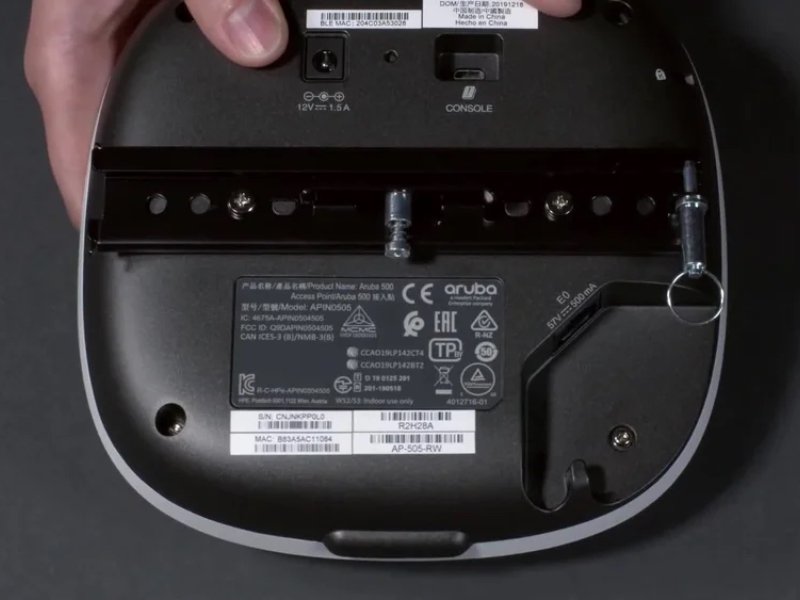
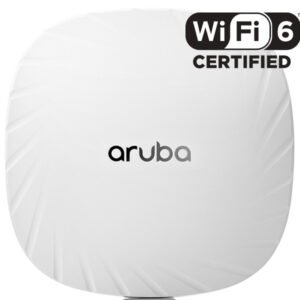

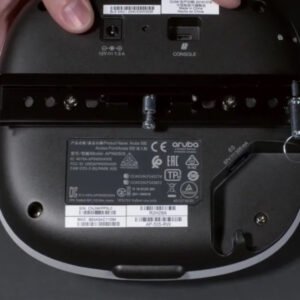

Reviews
There are no reviews yet.